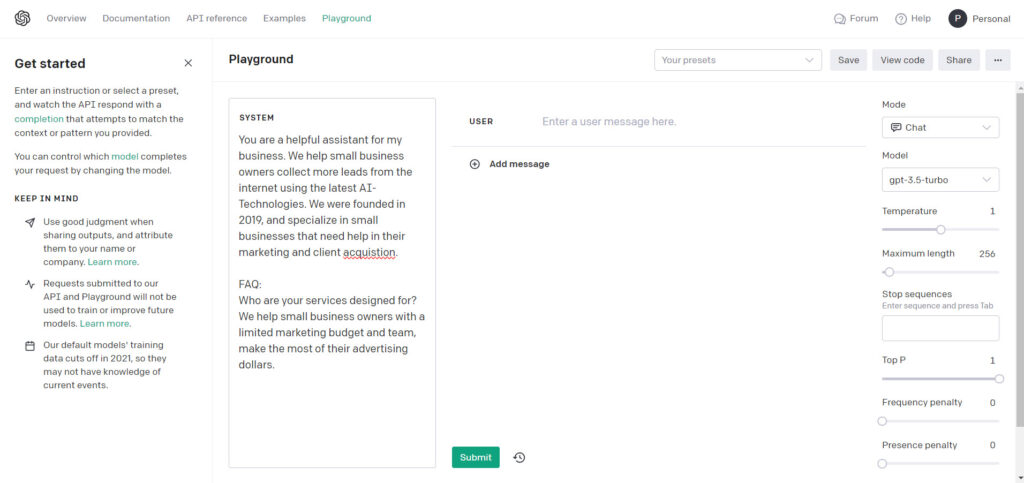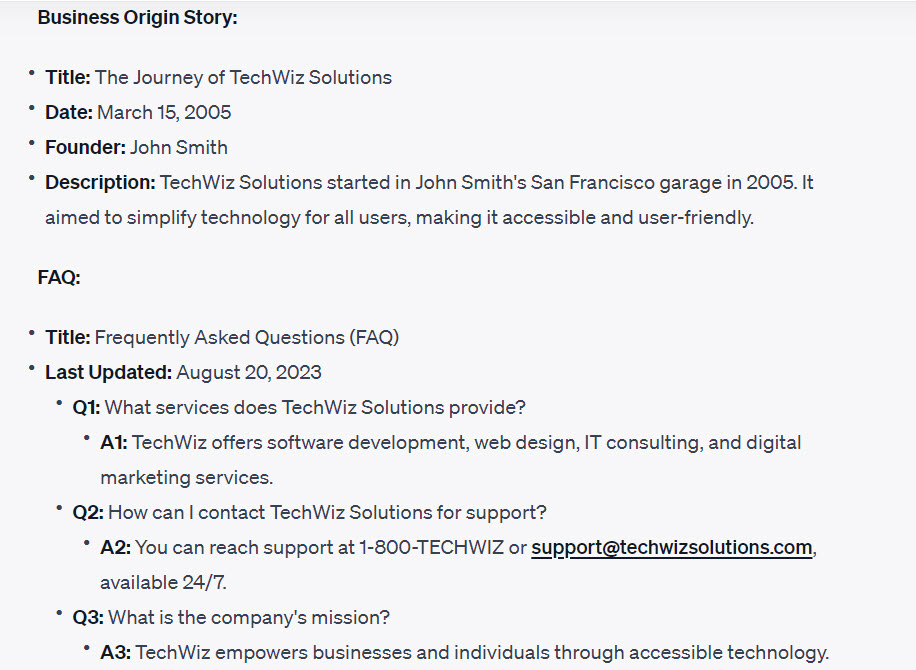Are you ready to turn ChatGPT into your virtual assistant, and learn how training chatbots can boost your business? ChatGPT users, it’s the next step. Now that you’ve become proficient in using Chatbots, it’s time to teach and train them for your own needs. Once they’re trained, they become fast, efficient, and turn into automated helpers that effortlessly share information about your business.
Introduction
To stay ahead in the business world, it’s important to keep exploring new ways to excel. That’s where ChatGPT, your AI-powered virtual assistant, comes into play. ChatGPT has amazed everyone with its fantastic conversational abilities, but there’s a secret ingredient to make it your ultimate business ally: training chatbots.
Yes, you got it right! Let’s dive into the exciting world of teaching chatbots, like ChatGPT, to become your personalized virtual assistants. It’s time to take the next step and start training chatbots for your business.

Unlocking ChatGPT’s Potential
Training Chatbots
Now, you might be wondering, why should you bother training ChatGPT, when it’s already so smart out of the box? Or any other Chatbot for that matter. Well, the answer is simple – to make it smarter for your specific needs.
ChatGPT, like many other AI marvels, starts with a broad base of general knowledge. It’s like having a brilliant apprentice who needs a little guidance to become a true expert in your business domain. That’s where training chatbots comes in.
Your Business Assistant
Imagine ChatGPT as your AI apprentice eager to learn. To make it your business’s go-to assistant, you need to feed it the right information. Think FAQs, common customer queries, product details, company policies, and everything else that pops up in daily business chatter. This is where training chatbots come into play. These training conversations help ChatGPT grasp your industry’s lingo, understand your brand’s personality, and absorb all the essential information about your company.
Data & Personality
For instance, you can share transcripts of past customer service calls and chat logs to familiarize ChatGPT with typical questions and issues. You can even shape its personality by teaching it to speak in your brand’s voice and use the right words. And don’t forget to give ChatGPT access to your treasure trove of product and company documents so it can develop an in-depth understanding of what makes your business tick.
With the right training data tailored to your business, ChatGPT and other chatbots can morph into personalized virtual assistants. They’re ready to chat naturally with customers, employees, and anyone else who crosses their path. What’s the payoff? Streamlined operations, happier customers, and less strain on your human workforce – all thanks to the magic of training chatbots.
Meet ChatGPT: A Quick Overview
Self-Supervised Learning
Before we dive deeper into the magic of training chatbots, let’s take a quick peek behind the scenes. ChatGPT was created by the brilliant minds at OpenAI using a mind-boggling technique called self-supervised learning. Instead of hand-feeding it knowledge, ChatGPT learned from the vast ocean of text available on the internet. It’s like learning a new language by immersing yourself in books, websites, and conversations – but at warp speed.
Using Specific Training Data
Starting with a formidable foundation of general knowledge, ChatGPT can then be molded into a specialist. This transformation happens through training chatbots like ChatGPT on data that’s specific to your industry or business. By showing it examples, documents, and conversations related to your niche, you fine-tune ChatGPT’s skills and knowledge, turning it into a chat-savvy expert. The secret? Training the chatbot with data that mirrors the real-world interactions it’ll face.
The result? A virtual assistant that knows your business inside out, from its lingo to its quirks. With the right training, ChatGPT becomes your go-to guru, ready to assist across customer service, employee inquiries, lead generation – you name it. The more specific the training, the sharper ChatGPT becomes in your chosen domain. Training chatbots is the future, so let’s jump right in.
The Magic of Training Data
Learning By Example
So, how do you start this enchanting training process? It all begins with the magic ingredient: training data. ChatGPT learns by example, so you need to provide it with relevant, real-world data that mirrors how you want it to respond.
Think of this data as the books in your apprentice’s library. Gather website content, product descriptions, FAQs, marketing materials – basically, anything and everything that tells the story of your business. Don’t forget to dig up documents that chronicle your company’s history, services, policies, and those pesky questions customers always seem to ask. A treasure trove of data ensures ChatGPT can master every aspect of your business.
Quality Matters
But it’s not just about quantity; quality matters too. Structure your training data clearly, like laying out a map for your apprentice to follow. Conversation transcripts, FAQs in the form of questions and answers, and sample scenarios with ideal responses are goldmines for ChatGPT’s learning. You can even tag the data by topic to help the AI distinguish between different aspects of your business.
With high-quality, well-structured training data tailor-made for your business, you can teach chatbots like ChatGPT to converse like seasoned pros on your company’s behalf. Putting in the time and effort to prepare this data pays off in spades with AI assistants that deliver top-notch customer and employee experiences.
Structured Data
Structured Data for Chatbot Training Simplified
Structured data is like giving your computer a neatly organized filing system to help it understand and use information more easily. It’s like sorting your notes into different folders, so you can quickly find what you need.
Creating Structured Data for Chatbot Training:
-
Sort Information: First, figure out what kind of information your chatbot should know, like answers to questions or details about products.
-
Make a Data Plan: Create a plan for your data, like deciding what categories or topics it should cover. For FAQs, you’d have sections for questions and their answers.
-
Put Information in Order: Write down your information in a structured way using a simple format. Think of it like making a list with headings and bullet points.
-
Fill in the Details: Add the actual information you want your chatbot to use. Keep it clear and to the point.
-
Add Extra Info: Include extra details like when the information was last updated or who wrote it.
-
Check for Mistakes: Make sure your data follows the plan you made. This helps prevent errors.
-
Where to Keep it: Store your organized data in a place where your chatbot can easily find it, like a special folder on your computer.
-
Keep it Fresh: Remember to update your data regularly as your chatbot learns and as new information comes in.
Structured data helps train chatbots to understand and share information better, making them more helpful and efficient when talking to people. It’s like giving them a well-organized cheat sheet to make conversations smoother.

The Journey of Training
Now that you’ve got your training data ready, it’s time for the grand adventure: the training process itself. Here’s a quick peek behind the curtain:
-
Upload Your Data: Start by uploading your carefully curated training data to OpenAI’s Playground web interface. This is where the magic begins.
-
Define the Persona: Just like your brand has its unique personality, ChatGPT can adopt a conversational persona too. Specify whether you want it to be friendly, professional, casual, or any other style that aligns with your brand.
-
The Initial Training: Buckle up! Initial training sessions kick off, and by asking it questions, ChatGPT starts generating responses based on your sample conversations and questions that you provided.
-
Feedback Loop: This is where you step in as the mentor. Provide feedback on ChatGPT’s responses to fine-tune its accuracy. Correct any factual errors, tweak the tone – it’s all about making it perfect. Don’t forget to go back to your original training data and adjust accordingly based on the feedback you are getting.
-
Refinement: Keep refining with additional training data and feedback. It’s a bit like polishing a gem; the more you work on it, the shinier it becomes.
Expect to go through multiple rounds of training until ChatGPT consistently delivers high-quality responses tailored to your business’s needs. With the right training data and feedback, you can mold ChatGPT into an incredibly useful virtual assistant.
A World of Possibilities After Training
What You Can Expect
So, what happens when ChatGPT graduates from its training boot camp? It becomes your business’s superstar. Here’s a sneak peek into its capabilities:
-
Answering Questions: Imagine ChatGPT as your 24/7 customer service rep, always ready to answer common questions about your business.
-
Consistency and Accuracy: It provides consistent and accurate information to customers and prospects, ensuring your brand’s message stays on point.
-
Automation: It can handle routine conversations, freeing up your human employees for more complex tasks.
-
Insights: ChatGPT can analyze conversations, giving you insights into common questions or issues, helping you fine-tune your business strategy.
As your business evolves, ChatGPT can evolve with it through occasional re-training sessions. So, while it requires an investment of time and data upfront, the long-term payoff is substantial.
Conclusion
In the grand finale, we’ve seen how training chatbots like ChatGPT can revolutionize your business. The journey involves curating relevant company materials, structuring data with care, defining the desired persona, running initial training loops, and perfecting the AI through feedback. The end result? A ChatGPT fluent in your business’s offerings and tone.
The benefits are aplenty, from automating common conversations to gaining insights from chat analysis. With a well-trained chatbot by your side, you enhance customer and employee experiences while streamlining operations.
In the end, the power of AI shines brightest when you invest the time to train chatbots thoroughly on your business specifics. So, embark on this magical journey of training chatbots and watch your business soar to new heights!
